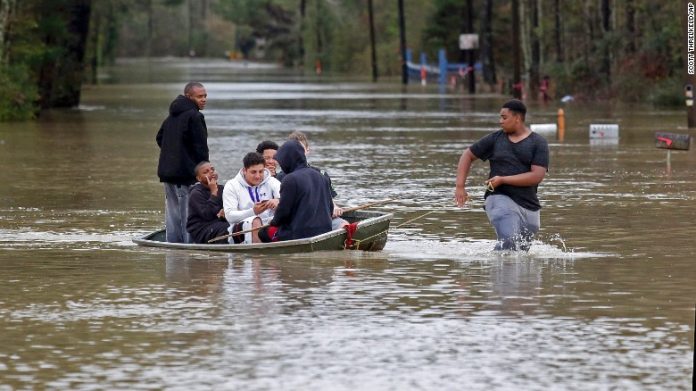
Historic flooding in Louisiana forced thousands from their homes and left at least four people dead, authorities said, with officials warning that the flood’s impact is far from over.
“Obviously, this remains a very serious event … and it remains ongoing,” Gov. John Bel Edwards (D) said during a news briefing late Sunday night. “This truly is a storm that has ravaged all of south Louisiana.”
More than 20,000 people were rescued from their homes through Sunday night, Edwards said during the briefing. The governor also said more than 10,000 people had been brought to shelters in southern Louisiana, most of them in the Baton Rouge region.
“We are going to get through this,” Edwards said, adding: “We have a lot of work ahead of us.”
The National Weather Service reported that four people were killed in the flooding, all by drowning. One man died after falling into a ditch while being helped through floodwater, while a woman who was riding in a truck was swept away by floodwater. The death toll had risen to six by midday Monday, according to the Associated Press.
The flooding dramatically impacted scores of people across Louisiana, forcing families to flee to safe ground and stranding people on waterlogged interstates.
Government offices across the state were shuttered Monday, while hundreds of state roads were closed because of high water. Scores of shelters were opened across Louisiana, with the largest number in East Baton Rouge Parish, the state’s biggest parish with more than 446,000 residents. Louisiana State University in Baton Rouge closed its campus again Monday and canceled freshman orientation.
On Sunday, the Louisiana State Police had worked to rescue people from hundreds of cars stranded on Interstate 12 just east of Baton Rouge, the state capital.
Edwards declared a state of emergency for all of Louisiana on Friday, and by Sunday he asked President Obama to declare the flooding a major disaster to open up access to federal funding.
“I have traveled to affected areas and have seen the destruction caused by this unprecedented flooding,” Edwards said in a statement on Sunday. He added: “This is an ongoing event, and we are confident that every available state and federal resource will be brought to bear.”
Obama on Sunday signed a disaster declaration for New Orleans, which makes federal funding available for people in four parishes: East Baton Rouge, Livingston, St. Helena and Tangipahoa. The White House said that Obama was briefed about the flooding by Lisa Monaco, his adviser for homeland security.
Edwards said that he expected more parishes would be “added to the declaration on a rolling basis.” The federal funds can help with home repairs, temporary housing and property losses.
By Monday morning, Edwards’ office said that 11,000 people had registered for Federal Emergency Management Agency assistance, most of them from parishes listed in Obama’s declaration.
Preliminary data from the National Weather Service said that in some parts of Louisiana, as much as 26 inches of rain fell. The rainfall at several reporting stations broke records, the agency said, as did the cresting rivers at various locations.
The U.S. Coast Guard said its crews had rescued dozens of people from Baton Rouge during the flooding, picking them up from rooftops, cars and trailers. In video footage posted online, a Coast Guard crew air-lifted people from a flooded area where the water was reaching the tops of buildings.
This flooding was caused by two weather-related features: extreme humidity and near-stationary low pressure that hovered over the Gulf Coast for days.
There were also incredible numbers measured for precipitable water — or how much moisture is in the air at any given time. In a statement issued Thursday, the National Weather Service noted that the amount of moisture in the atmosphere was “astoundingly high.”
The low pressure system that triggered the storms was not particularly strong, but it was more than enough to scour the moisture from the overly saturated atmosphere. The system had many of the same atmospheric features seen in tropical storms, and it sprawled across the Gulf Coast from Louisiana to the Florida panhandle.
(c) 2016, The Washington Post · Mark Berman

